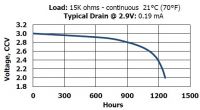Hello.
I need to get an estimate of the theoretical power consumption of the device and how long the battery will last before going on to experiment to confirm the estimates.
Current consumption for the systems included in the device:
Sleep state
HM-10 (400 uA)
Atmega8L (1.25 uA)
Active state
HM-10 (9 mA)
Atmega8L (1.6 mA)
I have two CR2032 batteries connected in parallel, so their total capacity is 240 + 240 mAh.
Battery discharge chart from documentation:

The battery voltage cannot drop below 2.7 V in the system, which, according to the diagram, gives approx. 1050 hours of operation under the tested conditions.
There are 2 batteries, so a total lifetime of 2100 hours. But the power consumption in the sleep state is about 400 uA and 190 uA for the graph. So I think it can be assumed (but I'm not sure) that the endurance is 2 times lower, i.e. 1050 hours for the sleep state.
The device works in the active state for about 0.5 seconds, say 10 times a day, which gives 5 seconds of the total duration of the active state per day, i.e. consumption of 10.6 mA.
Now I need to calculate somehow the average daily current, in order to estimate how long the battery will last for working both in active and sleep mode. How to count it? And are my simplifications in the presented analysis acceptable?
I need to get an estimate of the theoretical power consumption of the device and how long the battery will last before going on to experiment to confirm the estimates.
Current consumption for the systems included in the device:
Sleep state
HM-10 (400 uA)
Atmega8L (1.25 uA)
Active state
HM-10 (9 mA)
Atmega8L (1.6 mA)
I have two CR2032 batteries connected in parallel, so their total capacity is 240 + 240 mAh.
Battery discharge chart from documentation:

The battery voltage cannot drop below 2.7 V in the system, which, according to the diagram, gives approx. 1050 hours of operation under the tested conditions.
There are 2 batteries, so a total lifetime of 2100 hours. But the power consumption in the sleep state is about 400 uA and 190 uA for the graph. So I think it can be assumed (but I'm not sure) that the endurance is 2 times lower, i.e. 1050 hours for the sleep state.
The device works in the active state for about 0.5 seconds, say 10 times a day, which gives 5 seconds of the total duration of the active state per day, i.e. consumption of 10.6 mA.
Now I need to calculate somehow the average daily current, in order to estimate how long the battery will last for working both in active and sleep mode. How to count it? And are my simplifications in the presented analysis acceptable?


